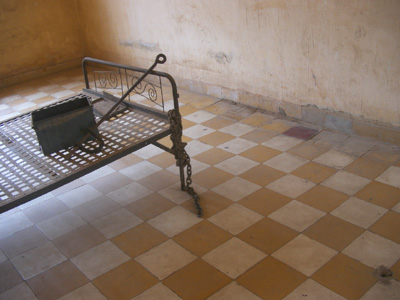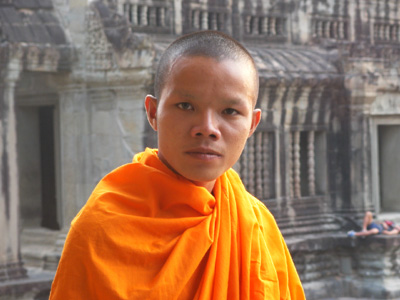Some subscribers might have already seen this piece, which recounts a trip to SE Asia in 2002.
Angkor What?!
After 27 years of being a tour escort and guide I turned the tables on myself, but with a twist, when I decided to see Cambodia in the company of a score of Cantonese-speaking Hong Kongers and a Cantonese-speaking guide. Except for bi-lingual Nancy, I made the trip in my little Anglophone world surrounded by the “static” of Cantonese and Khmer.
This left my information on Cambodia to the few books that I had read or had brought along, but I discovered that it had certain advantages. (Having just the right book(s) along is something I regard as an indispensable vademecum. ) I could retreat into my guidebooks and histories, or just lapse into a linguistically-induced aphasia and nobody took any notice or offence (as near as I could tell). If you’ve ever done group travel you understand this advantage. The others couldn’t say much negative about me since Nancy speaks and understands Cantonese. A minor problem was that I towered over and outweighed the rest of the group by a significant factor and I stopped looking Asian at about 18 months of age. So when I entered museums and architectural sites and restaurants with “my” group I frequently got questioned in Khmer with something I took to mean: “Hey, you no lookee Chinee. What, you try to sneakee in with Chinee group?”
The group consisted of a range of couples, singles, young and old, all, I would say, of middle and working class backgrounds. There was not a pretentious, overbearing, pushy, loutish, bitchy person in the group. OK, I’m excluding myself, but that’s still some sort of a record. Since I couldn’t communicate much with them (actually there were a few who had some English and two who were pretty good, but the language denominator was Cantonese and I left it to them to take the initiative), I had to give them names because I could not ask them theirs. It’s always to assign people names when they have some personality.
My favorite was a 72-year-old spry Chinese guy whom I dubbed Don Vito. The Don’s somewhat high-pitched, strained and hoarse voice would pass as a perfect impression of Marlon Brando playing the Godfather, Don Vito Corleone—if Corleone spoke Cantonese. I didn’t understand but a few words that this Don Vito spoke, but he always sounded like he was ordering his lieutenants to wipe out the Barzini and Tataglia families, or would that be the Wongs and the Cheungs. Don Vito did ask Nancy my name and she said to call me “James”. His reply was: “Ah, like James Bond, 007, license to kill.” I was right in naming him after a MAFIA don.
Don Vito was “accompanied” by a couple in their late 40s, friends, not relatives. I named him Sonny, after Santino Corleone, and she Sonny-girl. A skinny single guy in his early forties with thinning hair and a comic expression I named Roberto, after his resemblance to Italian actor Roberto Beningni. This made it easy for me to keep track of them, especially when their real names were something like Wong Chi-wing, or Kwok Ming-chu, and frequently written in Chinese characters. I gave most all of them names from movie or book characters, but had to be careful in referring to them that way, even if I was being called James Bond.
I did “bond” a little with the group by acting as their photographer. It remains a curiosity to me what compels Asians to have themselves photographed in front of things? Standing in front of an historical site, a hotel, a monument, and facing the camera, is the standard Asian tourist photo. Roberto, who was a single guy on the tour must have asked me two dozen times to take his photo in front of a temple, statue, or some other structure. He would set up the shot and mime to me how he would like it, the dash to the center of the frame and stand at rigid attention. The friends and family of a young couple in our group are not going to see a single view of anything in Cambodia that does not have him standing directly in front of it and with the same placid expression on his face, so unvarying that they will think that he was a spot on the camera lens or a blemish on the film.
But I never learned what my Cantonese traveling companions thought about Cambodia or the Cambodians.
Cambodians are about ninety percent Buddhists; so they strongly believe in re-incarnation. This is a good thing, because judging from their late Twentieth Century history and their present day conditions, their contemporary life sucks like that of few other countries in the world. The contributions of Nixon and Kissinger and their B-52s to political violence of the 1970s must be counted into the legacy of idiocy of the Vietnam War. In the past 30 years Cambodians have known very little peace, economic growth, or political stability. Today, much of the population lives at levels of well-being that can best be described as Neolithic. Kampongs and rural areas lack electricity, running water, sewerage, and the most rudimentary public services. Most roads are unpaved, rutted and unlit, and nearly impassable. Housing often consists of shacks and simple platforms on stilts that are little protection from the elements or from the breeding grounds for malaria that are to be found in the ubiquitous fens and other stagnant and fetid pools of water, sewage and debris. There is a thick and pervasive aroma of human waste and putrefaction in many areas.
Cambodians may endure these circumstances with considerable grace and good cheer because their religion promises a better afterlife. But that same religion may contribute to those very circumstances; feeling that the horrendous misdeeds of their political leaders will be appropriately settled in the afterlife they have allowed them to commit the most brutal and corrupt acts in history. Even in a century that has known the slaughter of Armenians, the Holocaust, the Rape of Nanking, the partition of India, Hutus slaughtering Tutsi’s with machetes, Bosnia and Kosovo, and the brutalities in much of Central and South America, the horrors of the Khmer Rouge may exceed them all. In a few years they managed to kill between two and three million of their brothers, sisters, parents and children, often employing methods of torture that would make Stephan King hug his teddy bear. The leaders they got achieved a level of brutality that was matched only by their stupidity. By turning schools into chambers of torture and execution, and emptying the cities of population and working and starving them to death or forcing them into cannibalism in the countryside they destroyed the social and economic infrastructure of their own country.

Cell from the infamous SR-21, a former school used as a torture factory
©UrbisMedia
And it shows. You can even feel it, too, like when we rode out of Phnom Penh to visit the infamous ‘Killing Fields,’ bouncing for miles on an unpaved and rutted road that must have been the last passage for hundreds of thousands. Today, the fields are a memorial. A structure later erected to commemorate the victims houses only a tower of skulls. Local kids, who seem to see this place as only an attraction for tourists from who they can beg, gambol over the sunken mass graves, unaware or unfazed by the grim tree with a red metal disk affixed to its trunk marking the point where thousands of babies’ heads were bashed before their bodies were thrown into the nearby mass grave. Another row of trees that were used for hangings, also remain. Bones and shards of clothing obtrude from the graves covering an area of several football fields. I’ve been to Dachau and Auschwitz, places of genocide; but the killing fields are more accurately a place of suicide, a nation in a frenzy of self-destruction.
It is a sad irony that many tourists are drawn to Cambodia by this wretched legacy, adding to the country’s paltry GNP by showing it’s worst excesses. I suppose that the Coliseum and Place De La Concorde are the same thing, but there’s not the immediacy of bones and bits of clothing or the blood spatters that are still visible on the walls of SR21, the school tuned into a torture chamber.
But people also go to Cambodia to see Angkor Wat, perhaps the most magnificent religious site in the world. This requires a flight from Phnom Penh to Siem Reap, the nearest large city to an area that contains not only Angkor Wat, but numerous equally awe-inspiring religious structures spread over a surprisingly wide geographic area. There isn’t much that can be said about these temples that doesn’t run one out of superlatives. How a civilization that produced these architectural, sculptural and spiritual wonders could have debased to the level of the Khmer Rouge is a real mind scruncher.
I had a suspicion I was going to be taken by the handsome young monk in saffron robes who was in the door leading into one of the labyrinthine passages that is Angkor Wat. “Want to see the best view.” he asked in reasonably good English. I followed and the attached photo is the result, that look of Buddhist serenity on his youthful features. I had a buck ready when he asked for a contribution “for the wat”. He pushed for five bucks. I said ‘no’. I was getting irked and felt like playing a little Abbot and Costello with him: “What wat?” “The money’s going to be used for what?” He’d say: “The Wat.” Then I’d say: “That’s what I asked, WHAT?” But I figured he wouldn’t get it.

Enterprising Buddhist monk at Angkor Wat
©UrbisMedia
Then he dropped to three bucks as we walked by down a corridor that would have been good for a multiple monk mugging (these are small monks). I said ‘no’ again, a little pissed now at the spiritual shakedown. We were at two bucks as we got to the doorway leading out into the open area. I put my hand on his shoulder in an avuncular way. I didn’t want us to part acrimoniously. “Look,” I said, “you should be content with my offering. You wouldn’t want to be re-incarnated as an Enron accountant, would you?” He seemed to be meditating on that as I made my leave.
___________________________________
©2003, James A. Clapp (UrbisMedia Ltd. Pub. 12.31.2003)

1 comment
Haha, interesting! 🙂
Comments are closed.